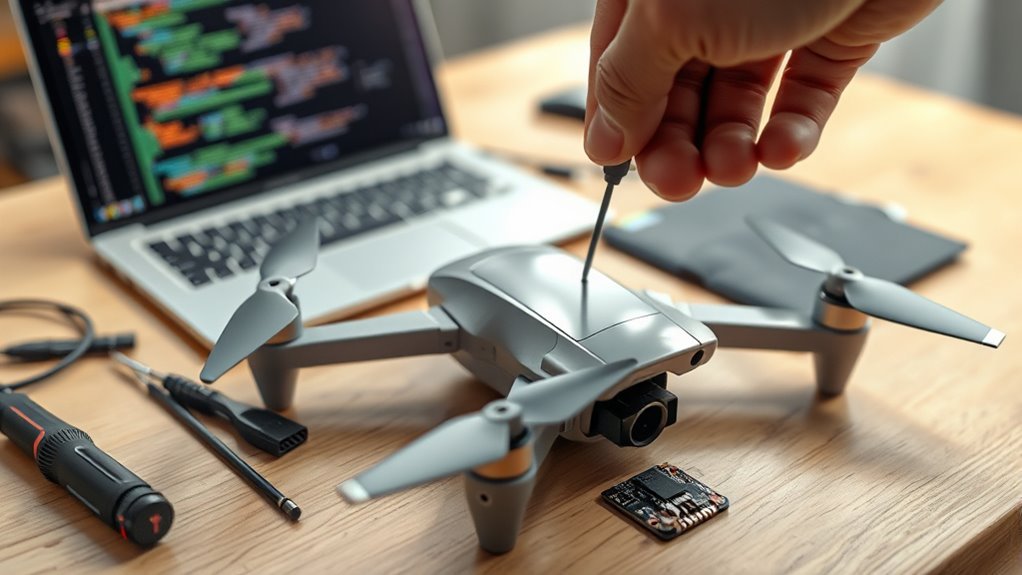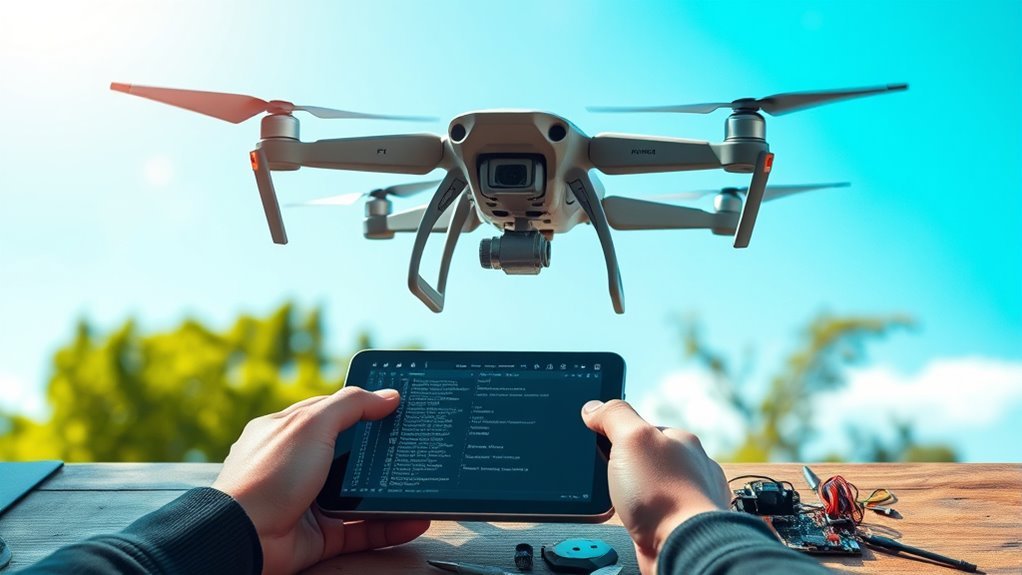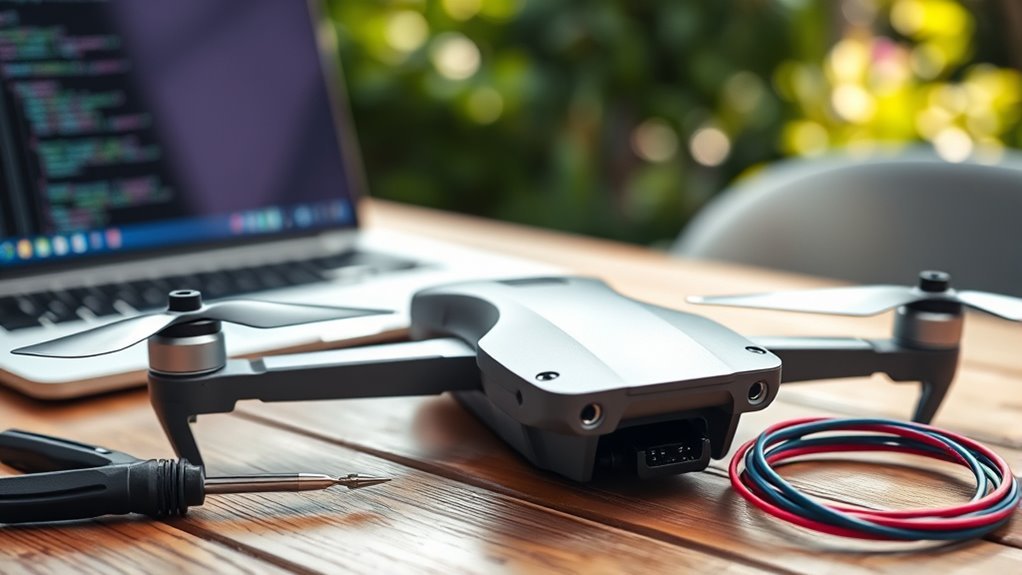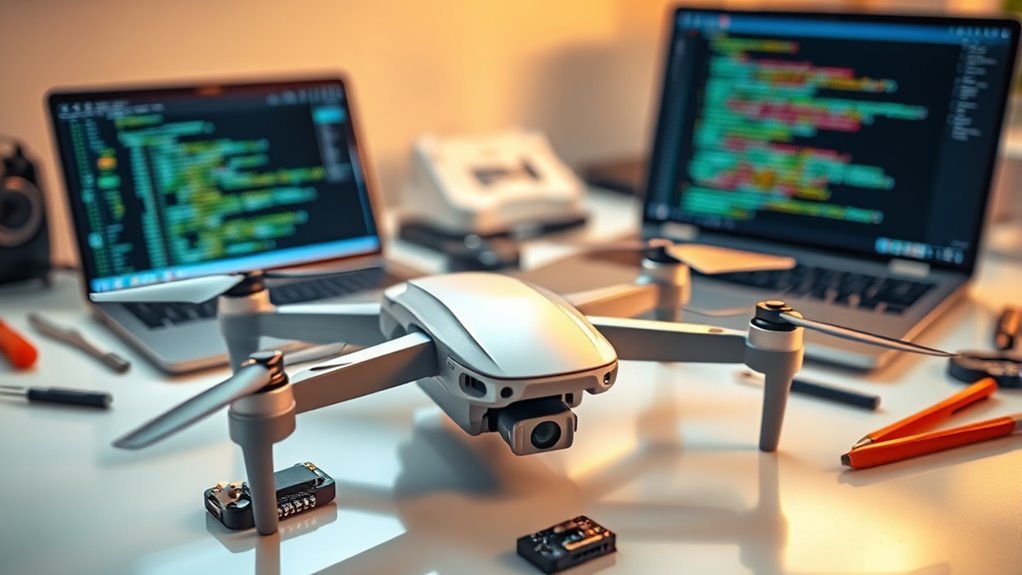To reprogram your drone, start by backing up current settings. Next, gather the necessary tools, including compatible software and a USB connection. Power on the drone and connect it to your computer. Download the latest firmware from the manufacturer’s website, ensuring compatibility with your model. Install the firmware, then perform flight tests and familiarize yourself with troubleshooting techniques for any issues. This process will enhance your drone’s performance, revealing more fine-tuning possibilities ahead.
Understanding Your Drone’s Firmware

While you may be enthusiastic to customize your drone’s performance, understanding its firmware is vital for effective reprogramming. Firmware acts as the bridge between hardware and software, dictating your drone’s capabilities. Each update can release new features or enhance existing functions, allowing you to tailor flight characteristics to your preferences. You’ll need to familiarize yourself with the firmware version currently installed on your drone, as compatibility with updates can vary greatly. Analyzing release notes will provide insights into improvements and potential issues. This knowledge empowers you to make informed decisions about which firmware updates to implement, ensuring you maximize your drone’s potential while maintaining operational stability. Understanding this foundational aspect is essential for achieving the freedom you seek in aerial exploration. Additionally, being aware of battery capacity is crucial, as it directly affects flight duration and performance consistency. Notably, the differences in flight time between various drone models can influence your decision-making when selecting firmware updates.
Gathering the Necessary Tools and Software

To effectively reprogram your drone, you’ll need specific hardware components, essential software applications, and the appropriate connection interfaces. Each of these elements plays a critical role in ensuring seamless communication and functionality. By gathering the necessary tools and software, you set the foundation for successful modifications. Additionally, ensuring your drone’s software includes advanced AI integration can significantly enhance its operational efficiency and adaptability. Moreover, implementing data-driven marketing strategies can help you identify the best enhancements to focus on for driving user satisfaction.
Required Hardware Components
Gathering the necessary tools and software for reprogramming your drone involves a few essential hardware components. To guarantee hardware compatibility and successful sensor integration, consider the following components:
| Component | Purpose |
|---|---|
| Flight Controller | Manages drone functions |
| Sensors | Collects data for navigation |
| Power Supply | Provides necessary energy |
These components are vital for achieving peak performance and flexibility. When selecting hardware, make sure each component aligns with your drone’s specifications and your programming goals. Proper integration is key to accessing the full potential of your drone, allowing you to customize and enhance its capabilities. Remember, investing in the right hardware now will save you time and frustration later.
Essential Software Applications
Essential software applications are critical for effectively reprogramming your drone and revealing its full potential. To start, make sure you choose applications that prioritize software compatibility with your drone’s firmware. This compatibility is crucial; mismatched software can lead to limitations in performance or functionality. Look for tools that feature a user interface designed for ease of navigation, enabling you to adjust settings and access features without confusion. Popular options include open-source platforms, which provide flexibility and community support. Additionally, consider simulation software that helps you test modifications virtually before applying them to the drone. By equipping yourself with the right software, you empower your drone to adapt and perform tasks tailored to your specific needs, enhancing your flying experience.
Connection Interfaces Needed
Having the right software applications is just one part of the equation; understanding the connection interfaces needed for reprogramming your drone is equally important. You’ll primarily rely on USB connections for direct data transfer, guaranteeing robust software compatibility with your drone’s firmware. Wireless interfaces, such as Wi-Fi or Bluetooth, offer flexibility, but they require careful consideration of signal strength and bandwidth requirements to maintain effective communication methods. Familiarize yourself with the relevant protocol standards to guarantee seamless integration between devices. Different programming tasks may demand varied data transfer rates, so knowing your options enhances your ability to customize your drone effectively. This knowledge empowers you to maximize your drone’s capabilities, giving you the freedom to explore new horizons.
Backing Up Your Current Settings

Backing up your current settings is essential to prevent data loss during the reprogramming process. You’ll want to familiarize yourself with various backup methods available for your drone, as well as the steps to restore your settings if needed. This guarantees a seamless changeover and minimizes downtime, allowing you to maintain peak performance.
Importance of Backup
Before diving into reprogramming your drone, it’s essential to guarantee that you’ve backed up your current settings. This precaution safeguards against potential data loss during the reprogramming process, ensuring that you don’t lose valuable configurations. A backup serves as your safety net, allowing you to restore previous settings if needed, which is important for maintaining system stability. Without this step, you risk encountering unexpected issues that could compromise your drone’s performance or operational integrity. By securing your current settings, you empower yourself to explore new programming possibilities with confidence, knowing you can revert to a reliable state if things go awry. In the world of drone programming, a reliable backup is your best ally.
Backup Methods Overview
When it comes to backing up your drone’s current settings, understanding the available methods is essential for ensuring a seamless changeover during reprogramming. You have two primary options: cloud storage and external drives. Each method has its advantages, depending on your specific needs and preferences.
| Method | Advantages |
|---|---|
| Cloud Storage | Accessible anywhere, automatic syncing |
| External Drives | Large capacity, offline access |
Using cloud storage allows you to access your settings from any device, while external drives provide a physical backup. Whichever method you choose, make sure you follow the instructions carefully to avoid losing your valuable settings. Your freedom to customize your drone starts with a solid backup plan!
Restoring Settings Process
Restoring your drone’s settings is a straightforward process that can be completed in just a few steps. First, make sure you’ve backed up your current configurations. This step is essential as it allows you to revert to your preferred settings if needed. To initiate the restoring process, navigate to the settings menu on your drone’s interface. Select the option for resetting configurations. If you want to return to the original factory settings, choose the factory reset option. Confirm the action and wait for the process to complete. After the reset, you can reapply your backed-up settings to regain your customized setup. This method provides flexibility and control over your drone’s performance, guaranteeing your flying experience remains tailored to your preferences.
Connecting Your Drone to Your Computer
To connect your drone to your computer, you’ll need to verify both devices are ready for the process. First, make sure your drone is powered on and in pairing mode. Next, plug in the USB cable to your computer and the drone’s port. If you encounter any drone connectivity issues, check that the appropriate USB driver installation is complete. This is essential for your computer to recognize the drone. If the driver isn’t installed, visit the manufacturer’s website for the latest version. Once connected, your computer should display the drone as a device, allowing access for programming. It’s important to ensure that your drone operates on the 2.4 GHz and 5.8 GHz frequency bands to maintain a stable connection. Additionally, verify that your drone’s advanced camera capabilities are functioning correctly to ensure optimal performance and image quality. Confirm the connection before proceeding to the next steps, as proper connectivity is important for successful reprogramming.
Downloading the Latest Firmware
After confirming your drone is connected to your computer, the next step is downloading the latest firmware. This process guarantees your drone operates efficiently and is compatible with the latest features. Follow these steps to secure the necessary firmware updates:
- Visit the manufacturer’s website for firmware downloads.
- Verify that the firmware version matches your drone model for compatibility.
- Download the latest firmware file to your local drive.
- Check for any release notes to understand new features or fixes.
Installing the New Firmware
Once you’ve downloaded the latest firmware, you can begin the installation process, which is vital for guaranteeing your drone operates with enhanced functionality and stability. First, connect your drone to a computer via USB. Open the firmware update software provided by the manufacturer. Follow the installation procedures carefully; this typically involves selecting the downloaded firmware file and initiating the upload. Confirm that the drone’s battery is fully charged to prevent interruptions during the process. Once the upload completes, the software will prompt you to restart the drone. This step is essential, as it allows the new firmware updates to take effect. After the reboot, verify the installation by checking the firmware version in the settings menu. Additionally, ensure that you stay updated with frequent, feature-rich enhancements from the manufacturer to maintain optimal performance. Your drone is now ready for optimized performance.
Testing Your Reprogrammed Drone
With the firmware successfully installed, it’s time to evaluate your drone’s performance under the new software. Begin with flight performance assessments to confirm stability and responsiveness. Conduct range tests to verify if the new programming enhances control and connectivity.
- Monitor battery life during various maneuvers, as battery types can significantly influence your drone’s performance.
- Test different flight modes to gauge versatility.
- Observe any latency in response to controls.
- Record data for future comparisons and adjustments.
Engaging in these tests will help you understand how the reprogramming affects your drone’s capabilities. Collecting this data not only guarantees peak performance but also empowers you to fine-tune settings for your specific needs, allowing for a more liberated flying experience. Additionally, consider the impact of battery efficiency on your flight duration and overall performance.
Troubleshooting Common Issues
When issues arise with your reprogrammed drone, having a systematic approach to troubleshooting can save time and frustration. Start by checking battery issues; verify it’s fully charged and properly connected. If the drone isn’t responding as expected, consider recalibrating it. This involves adjusting the gyroscope, accelerometer, and compass according to your manufacturer’s specifications. A poor calibration can lead to erratic flight behavior. Additionally, inspect the firmware; outdated software might cause operational glitches. If you encounter connectivity problems, try resetting the drone’s settings. Signal strength and communication limits can also impact responsiveness, so ensure that you are within the optimal range. Be mindful that weather conditions can also affect performance, especially if there are strong winds or precipitation. Document each step you take, so you can identify patterns in recurring issues. By systematically addressing these common problems, you’ll maintain your drone’s performance and enjoy the freedom it offers.
Frequently Asked Questions
Can I Revert to the Old Firmware After Updating?
Yes, you can revert to the old firmware if it’s compatible. Make certain you understand the rollback process thoroughly, as compatibility issues might arise. Always back up your settings before attempting any firmware changes for ideal freedom.
How Often Should I Update My Drone’s Firmware?
You should update your drone’s firmware regularly, ideally every few months. This update schedule enhances performance, adds features, and addresses security vulnerabilities, ensuring you maximize the firmware benefits while enjoying greater freedom in your flying experience.
Will Reprogramming Void My Drone’s Warranty?
Reprogramming your drone’s like altering a bird’s flight path; it can lead to warranty implications. Always check the manufacturer policies, as unauthorized modifications might void your warranty, limiting your freedom to explore the skies.
Can I Use Third-Party Firmware for My Drone?
You can use third-party firmware for your drone, but be aware of firmware risks. While third-party benefits include enhanced features, they may also lead to instability or compatibility issues, impacting your overall flying experience.
What Should I Do if My Drone Won’t Connect?
When your drone won’t connect, it’s like hitting a brick wall. Start with basic drone troubleshooting tips, check battery levels, restart the device, and explore connectivity issues solutions for a smoother flight experience.

